|
There is a lot going on with TrophyCatch this quarter! For starters, the program has reached 10,000 Lunker Club (8-9.9 lbs.) fish submitted, bringing the grand total of approved TrophyCatch submissions to an amazing 12,969 bass!
- 10,271 Lunker Club (8-9.9 lbs.)
- 2,578 Trophy Club (10-12.9 lbs.)
- 120 Hall of Fame (13+ lbs.)
- 12,969 TOTAL approved submissions to date
The Season 9 Hall of Fame Ceremony at Bass Pro Shops Gainesville was well-attended with 21 winners present to receive and display their catches of bass weighing 13 pounds or heavier.
The exciting day of Trophy Bass with Lowrance concluded with the Season 9 Hall of Fame Ceremony at Bass Pro Shops Gainesville, and 21 of our Hall of Fame anglers with approved catches of bass weighing 13 pounds or heavier attended to compare fish stories and receive their replica mounts by Gray Taxidermy! David Free is the Season 9 TrophyCatch Champion with the largest approved bass: his 14 lbs. 12 oz. monster was caught-and-released in a St. Johns County pond. It was a fun event bringing together TrophyCatch partners and an elite group of anglers to share the fun of an awesome bass fishing experience.
 |
Next up, in celebration of TrophyCatch's tenth season and a decade of trophy bass catches, biologists with the FWC have tagged and released 10 largemouth bass with bright pink tags in 10 different locations across the state. If caught, one tag could be worth $6,000 or more in prizes! Bass Pro Shops, a proud plank-partner of TrophyCatch, is providing up to $50,000 in gift cards in honor of the company’s 50th anniversary celebration this year. Winners of the pink-tagged bass can also receive gift cards for AFTCO merchandise and a chance to win cash award money.
So far pink tags are swimming in Lake George, Lake Griffin and Lake Istokpoga! To see the entire list and to learn more about the tagging waters visit TrophyCatch.com. Make sure to follow all the tagging-action on Facebook/TrophyCatchFlorida! Then, quit wishin' and go fishin' for a pink tag!
To claim their prize, lucky anglers landing a bass with a pink tag must follow the submission instructions on the TrophyCatch 10-TAG webpage. The bass must be submitted to TrophyCatch under TrophyCatch rules to qualify. Bookmark the TrophyCatch 10-TAG webpage to stay updated on this special promotion and to plan your next fishing adventure!
 Have you seen something absolutely awesome in your day so far? Look no farther! Media 1 / Wrap This was on board with FWC biologists for a day on the water to learn all about ELECTROFISHING. Being a fisheries biologist isn't always this much fun, but this is about as fun as it gets! Check out this absolutely amazing video as they show us how it's done!
https://www.youtube.com/watch?v=AJMHT5OzuSc
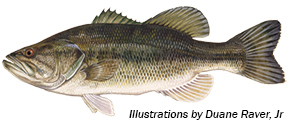
Size: The state record is 17.27 lbs, though several larger fish have been reported but not certified. Any bass 8 pounds or larger is considered a trophy, and eligible for FWC's TrophyCatch program (see above—bass must be released). The Big Catch certificate program minimum qualifying sizes are 24 inches or 8.0 pounds for adults, and 18 inches or 6.0 pounds for youth (BigCatchFlorida.com).
Appearance: The Largemouth Bass is the best known and most popular game fish in North America. It is distinguished from other black bass species found in Florida (Shoal, Choctaw, Suwannee and Spotted basses) because the upper jaw extends beyond the rear edge of the eye, giving the largemouth its name. The first and second dorsal (back) fins are also separated by an obvious deep dip.
|
Largemouth Bass: Upper jaw extends past eye, and first and second dorsal fins are separated.
Shoal, Choctaw, Suwannee and Spotted basses: Upper jaw does NOT extend past eye, and first and second dorsal fins are connected.
Range: As the "Bass Fishing Capital of the World" Florida offers many excellent opportunities, but some of the "Top Spots" include the Escambia River, Lake Rousseau, Fellsmere Water Management Area, the Winter Haven Chain of Lakes, and Lake Okeechobee. See the Black Bass Top Spots list for more information and other great sites to try.
Habitat: The adaptable largemouth bass is found throughout all of Florida's fresh waters, from lakes and streams to rivers and canals. It would be hard to find a water where you couldn't catch one!
Behavior: Largemouth bass have been known to spawn between December-June in Florida, but by far most spawning occurs February-April. The triggering water temperature for bass is between 62-75 degrees F. The smaller male will build a shallow nest between 20-30 inches in diameter (roughly twice the size of the individual male building the nest). The female will lay her eggs in the bed, and the male will fertilize the eggs as they are released. Large females may lay as many as 100,000 eggs. Following spawning the male will continue to guard the eggs, which usually hatch within 3-4 days. This parental protection will continue another 2-1/2 to 3 weeks while the bass fry congregate in schools, ending once the fry reach approximately 1/4-3/8 inch in size and begin to disperse.
Sporting Quality: The Largemouth Bass is king of Florida's freshwater fishing! This aggressive fish will strike almost any artificial, but plastic worms, minnow imitations, crankbaits, spinnerbaits, and various topwater lures produce the most bass. Flipping with jigs or plastics in heavy vegetation will often take fish when other methods fail. The best live bait is a golden shiner, fished under a float or free-lined. Typical bass tackle consists of a medium to medium-heavy rod, matched to a spinning or baitcasting reel spooled with 8-20 pound monofilament or braid depending on fishing conditions.
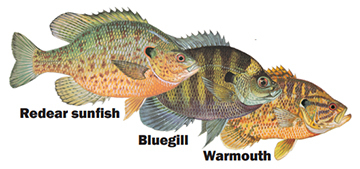
Most anglers start fishing in fresh water, often from a bank or pier, and their first catch is usually a bream. The image of a boy and his dog, with a cane pole and a can of worms, brings to life a symbol of the American tradition of fishing and stresses the ideal of youth connecting with nature and learning independence. Florida’s 8,000 named lakes and ponds and 12,000 miles of streams and rivers, brim with bream. “Bream” is a local term used throughout the Southeast and includes various deep-bodied panfish from the sunfish family. The most common are bluegill, redear sunfish (shellcracker), spotted sunfish (stump-knocker), and warmouth. Although black bass are in the sunfish family, they are not considered to be bream. Almost any water body
in the Sunshine State, regardless of size or locale, contains hungry bream.
Shellcracker often spawn during March or early April, and will bed well into August. Bluegill will begin bedding about a month after shellcracker (April or May), periodically spawning throughout the summer and even as late as November in south Florida. Bedding bream will usually be found in water depths ranging from 3 to 10 feet.
|

Bluegill are easily the most popular “bream” in Florida because of their abundance and availability, although the equally tasty and somewhat larger shellcracker appeal to many anglers. Found in lakes, streams, rivers, ponds, and canals, bluegill are caught on a wide variety of live offerings including earthworms, crickets, and grass shrimp. Anglers who use spinning gear won’t go wrong when tossing or trolling tiny beetle spins. Fly rod buffs particularly enjoy this little scrapper because of its eagerness to clobber both popping bugs and sinking flies. Ounce-for-ounce, the abundant bluegill is a strong battler when not over-tackled. Those caught will range from an average of 6-8 ounces to an occasional 1-pounder.
“Shellcracker” is the locally popular name for the redear sunfish, the Sunshine State’s largest “bream,” which is easily identified by the red margin at the edge of its gill flap. The average size for redear sunfish is about 10-12 ounces, but 1-pound fish are frequently caught on spawning beds. Favored live baits include snails, mussels, earthworms, crickets, and grass shrimp. Redear are less frequently caught on artificial lures, but fly-rodders can occasionally connect with this hard fighter by casting popping bugs with a small sinking fly tied to an 18-inch light monofilament dropper. Shellcracker usually hang around areas with hard, sandy bottoms or shell beds, but may also be targeted near grass patches, pads, reeds, snags, and stick-ups.
If panfishing is your passion, don’t overlook Florida’s many streams, rivers, and canals for more opportunities. These gems are teeming with spotted sunfish (stumpknocker) and warmouth. Although none of these fish grow to the proportions of their bluegill and redear cousins, they are worthy fighters for their size—and tasty, too. Spotted sunfish and warmouth will typically be found near woody structure, while redbreast sunfish favor vegetation such as lily pads or eel grass. Earthworms are the best live bait for this pair, but small spinners and popping bugs also work well.
Fish illustrations by Duane Raver, Jr.
|
Size: 4 Lakes
Location: Polk County
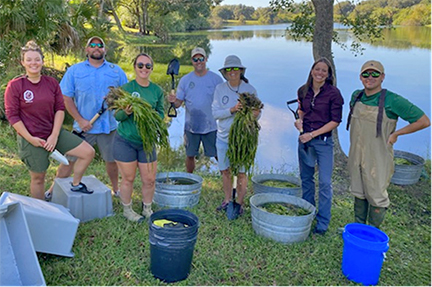
Description: In 2021, FWC staff partnered with the City of Bartow to increase urban fishing opportunities at Mary Holland Park in Polk County, Florida. Affectionately termed "The Gem of Bartow" by residents of this small city, the park provides multi-use recreational opportunities in an urban setting. The park has four small lakes, a large walking trail, children's playground, and several youth soccer fields. The lakes of Mary Holland Park are reclaimed phosphate pits, with steeply sloping shorelines and depths upwards of 25 feet. The unique nature of phosphate pit lakes creates excellent fishing opportunities.
However, due to the bank’s steep slopes and depths, there is limited aquatic vegetation in the lakes. To create better fishing opportunities and increase bank angler success, FWC biologists recently completed a project to enhance the lakes’ submersed aquatic habitat. Mature Eelgrass plants, reared at FWC’s Richloam Fish Hatchery, were harvested, transported, and replanted into two lakes at Mary Holland Park. Biologists are monitoring both transplant sites and remain optimistic that the Eelgrass will establish and expand along the park’s shoreline.
|
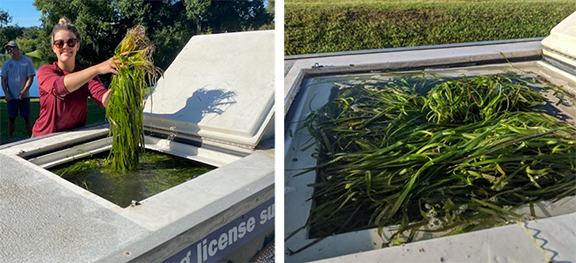 |
Eelgrass transplanted into Mary Holland Park will create prime game fish habitat and improved fishing.
FWC biologists also conducted electrofishing surveys, where they documented several healthy sportfish populations including Largemouth Bass, Bluegill Sunfish and Black Crappie. However, they didn’t observe an abundance of catfish species, which are often targeted by bank anglers. To help bolster the population, 2,000 Channel Catfish were divided and stocked into three of four lakes at Mary Holland Park. Biologists hope that supplemental stocking will create better
nearshore fishing opportunities for the park’s recreational anglers. Future stockings at Mary Holland Park will focus on Sunshine Bass. The stocking of this unique Florida sportfish will create an entirely new urban fishing opportunity for Polk County residents. Biologists hope these fish will garner attention to the park and its unique fishing opportunities, putting Mary Holland on the map as a must-fish destination in central Florida.
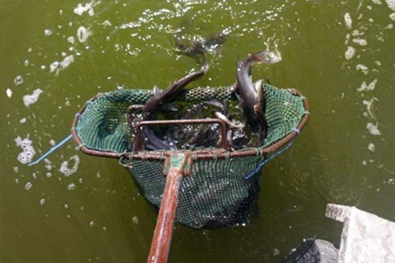 |
Channel catfish stocking provides an additional species for Mary Holland Park anglers to target.
To contact the Florida Freshwater Angler, email John Cimbaro. Fish illustrations by Duane Raver, Jr. and Diane Rome Peebles.
|